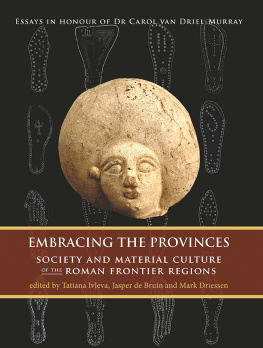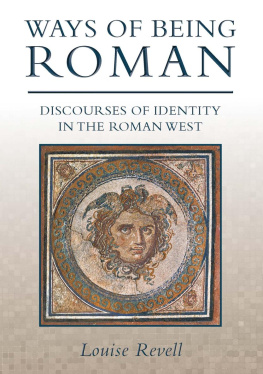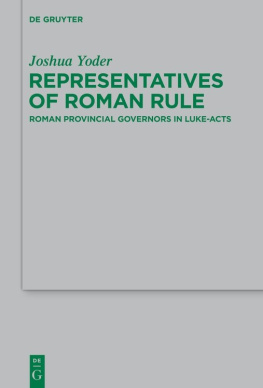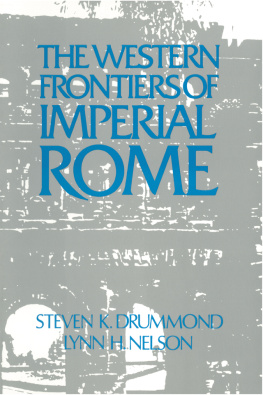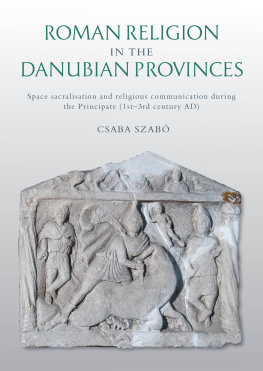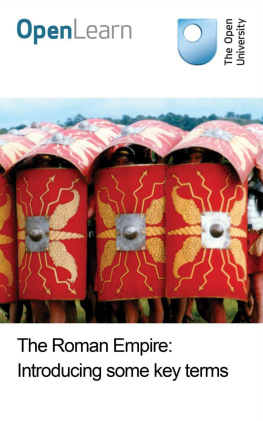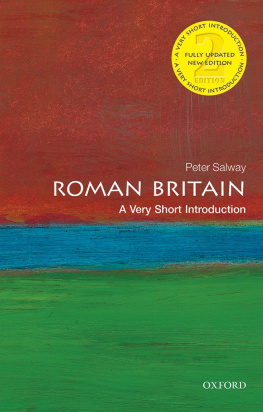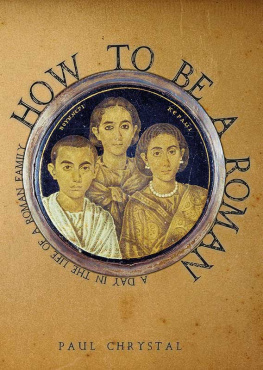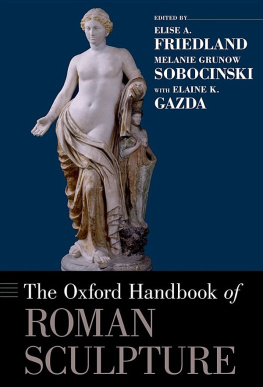Embracing The Provinces

EMBRACING THE PROVINCES
EMBRACING THE PROVINCES
SOCIETY AND MATERIAL CULTURE OF THE ROMAN FRONTIER REGIONS
Essays in honour of Dr Carol van Driel-Murray
Edited by
TATIANA IVLEVA, JASPER DE BRUIN AND MARK DRIESSEN
Published in the United Kingdom in 2018 by
OXBOW BOOKS
The Old Music Hall, 106108 Cowley Road, Oxford, OX4 1JE
and in the United States by
OXBOW BOOKS
1950 Lawrence Road, Havertown, PA 19083
Oxbow Books and the individual authors 2018
Hardback Edition: ISBN 978-1-78925-015-2
Digital Edition: ISBN 978-1-78925-016-9 (epub)
Kindle ISBN: 978-1-78925-017-6 (mobi)
A CIP record for this book is available from the British Library
Library of Congress Control Number: 2018953923
All rights reserved. No part of this book may be reproduced or transmitted in any form or by any means, electronic or mechanical including photocopying, recording or by any information storage and retrieval system, without permission from the publisher in writing.
For a complete list of Oxbow titles, please contact:
UNITED KINGDOM
Oxbow Books
Telephone (01865) 241249
Email:
www.oxbowbooks.com
UNITED STATES OF AMERICA
Oxbow Books
Telephone (800) 791-9354, Fax (610) 853-9146
Email:
www.casemateacademic.com/oxbow
Oxbow Books is part of the Casemate Group
Front Cover: (main) a head of Matrona found in Zwammerdam ( Provincial Archaeological Depot South Holland); (background) drawings of shoes from personal archive of Carol van Driel-Murray.
Back Cover: (top left) Bronze plate from a gladius found in Valkenburg (ZH) kept in the National Museum of Antiquities, Leiden, the Netherlands, inv. no. 1991/9.3679_1 ( National Museum of Antiquities); (top right) South Gaulish samian ware sherd (Hofheim 1) with graffito of a galley, found in Vechten (Photo: PUG-collection Municipality of Utrecht (NL))
Acknowledgements
The editors wish to express gratitude to all contributors who enthusiastically responded to our calls to produce this gift for our beloved Carol and submitted their interesting and challenging papers in timely manner. Warm thanks for bearing with us during the production of this volume.
We would like to thank the organisations, who kindly provided grants to produce the colour plates, namely the Marc Fitch Fund and the Archaeological Leather Group. A special thank you is due to the group of Roman Provinces, Middle Ages and Modern Period, Faculty of Archaeology, Leiden University, for their financial assistance in making this volume possible. Marcus A. Roxburgh and Mark Locicero helped with the final copy-editing of the contributions, and the editors are very grateful for their help.
Abbreviations
| AE | LAnne pigraphique |
| CIL | Corpus Inscriptionum Latinarum |
| IGRR | Inscriptiones Graecae ad Res Romanas Pertinentes |
| ILS | Inscriptiones Latinae Selectae , Dessau, H. (ed.) 18821916 |
| LUPA | Ubi Erat Lupa catalogue of Roman sculpture: http://www.ubi-erat-lupa.org |
| RIB | The Roman Inscriptions of Britain |
| Tab. Vindol. I | Bowman, A. K. and Thomas, J. D. (1983) Vindolanda: the Latin Writing Tablets . Britannia Monograph 4. London, Society for the Promotion of Roman Studies |
| Tab. Vindol. II | Bowman, A. K. and Thomas, J. D. (1994) The Vindolanda Writing-Tablets (Tabulae Vindolandenses II) . London, British Museum |
| Tab. Vindol. III | Bowman, A. K. and Thomas, J. D. (2003) The Vindolanda Writing Tablets (Tabulae Vindolandenses III) . London, British Museum |
Contributors
L INDSAY A LLASON -J ONES
School of History, Classics and Archaeology, Newcastle University
P ENELOPE M. A LLISON
School of Archaeology and Ancient History, University of Leicester
B ARBARA B IRLEY
Vindolanda Trust
D AVID J. B REEZE
36 Granby Road, Edinburgh
C LIVE B RIDGER
LVR-ABR, Auenstelle Xanten
J ASPER DE B RUIN
Faculty of Archaeology, Leiden University
M ARK D RIESSEN
Faculty of Archaeology, Leiden University
H ARRY VAN E NCKEVORT
Bureau Leefomgevingskwaliteit en Archeologie, Nijmegen Municipality
M ICHAEL E RDRICH
Instytut Archeologii Uniwersytet Mari Curie-Skodowskiej, Lublin
E RIK P. G RAAFSTAL
Utrecht Municipality
E LIZABETH M. G REENE
Department of Classical Studies, University of Western Ontario
J ENNY H ALL
Institute of Archaeology, University College London
I AN H AYNES
School of History, Classics and Archaeology, Newcastle University
T ATIANA I VLEVA
School of History, Classics and Archaeology, Newcastle University Faculty of Archaeology, Leiden University
S IMON J AMES
School of Archaeology and Ancient History, University of Leicester
F LEUR K EMMERS
Institut fr Archologische Wissenschaften, Abt. II, Goethe Universitt, Frankfurt am Main
L AURA I. K OOISTRA
BIAX Consult, Zaandam
A NNELIES K OSTER
Museum Het Valkhof, Nijmegen
Q UITA M OULD
Barbican Research Associates
U RSULA R OTHE
The Open University
Carol van Driel-Murray: an appreciation
David J. Breeze
It is not given to many of us to change the perceptions of our colleagues within our disciplines, but Carol has done this not once but twice. Her work on leather and on women in the Roman world are the two crucial aspects of her work which have affected our understanding of the past and challenged us to look at these topics with different eyes. In her work she has frequently made use of comparative examples, and she has cheerfully acknowledged her own learning experience along the way (cf . her own comments in van Driel-Murray 1995, 19). But first, Carol herself.
Carol van Driel-Murray appears to be the quintessential Dutch lady. Stocky figure (forgive me Carol), blond hair, which used to be wrapped round in a plait, and a gift for languages. But she is British, English in fact, though with a Dutch mother. She was born in Isleworth, Middlesex (a historical conundrum for it is a county which no longer exists) on 20 May 1950. She read archaeology at Liverpool University, graduating in 1971. Soon afterwards she moved to the Netherlands and in 1975 married Govert van Driel, an Assyriologist at the University of Leiden, adopting the Dutch order of surnames. In the same year, Carol became a member of the research staff at the Institute of Pre- and Protohistory in the University of Amsterdam, rising to lecturer in 1982. In 1987, she was awarded her PhD for Studies in Leatherwork from Roman Archaeological Sites in North-Western Europe by the University of Amsterdam. A student defending their thesis is allowed two supporters, and Carol chose two members of the Ermine Street Guard to aid her defence, an indicator of how she is revered by the re-enactment fraternity. As it happens, the two soldiers did not have to come to her aid, but stood stolidly, in Roman armour, to each side of the candidate throughout the viva. In 2012 Carol transferred to the Faculty of Archaeology in the University of Leiden, then under the leadership of Willem Willems. She retired in September 2015.
The bulk of the work of a finds specialist is published some might say, buried in excavation reports, and this is no less true with Carol. These reports started many years ago, but have continued up to the present day with a paper on the shoes found at the Roman military site at Camelon beside the Antonine Wall in Scotland (van Driel-Murray and Arkesteijn 2015). Over these years, Carol has published reports on leather from Roman and medieval sites in Belgium, Britain, Germany and the Netherlands. Often, she has shown the value of studying leather, for example, when through her analysis of the shoes of the captain of the ship De Meern 1 she was able to demonstrate a date of about 190 for its accidental sinking. Carol has always been keen to place her shoes into a wider context.

